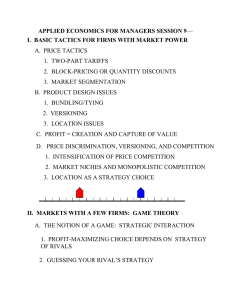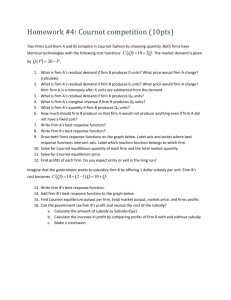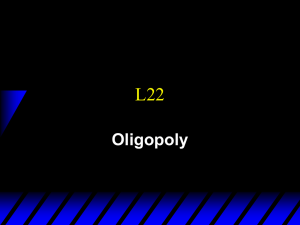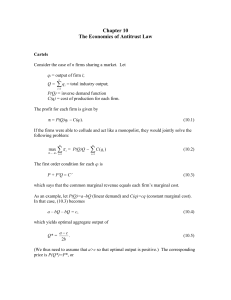TERM PAPER 2 ECON 4820 Strategic Competition
advertisement
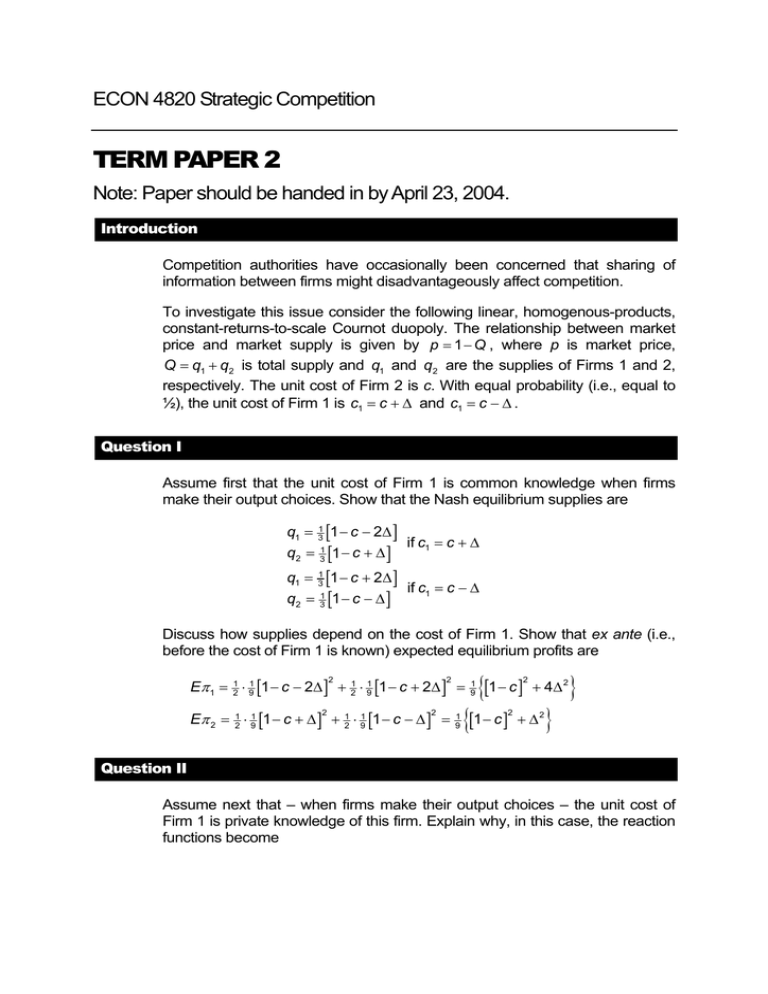
ECON 4820 Strategic Competition
TERM PAPER 2
Note: Paper should be handed in by April 23, 2004.
Introduction
Competition authorities have occasionally been concerned that sharing of
information between firms might disadvantageously affect competition.
To investigate this issue consider the following linear, homogenous-products,
constant-returns-to-scale Cournot duopoly. The relationship between market
price and market supply is given by p = 1 − Q , where p is market price,
Q = q1 + q2 is total supply and q1 and q2 are the supplies of Firms 1 and 2,
respectively. The unit cost of Firm 2 is c. With equal probability (i.e., equal to
½), the unit cost of Firm 1 is c1 = c + ∆ and c1 = c − ∆ .
Question I
Assume first that the unit cost of Firm 1 is common knowledge when firms
make their output choices. Show that the Nash equilibrium supplies are
q1 = 31 [1 − c − 2∆ ]
if c1 = c + ∆
q2 = 31 [1 − c + ∆ ]
q1 = 31 [1 − c + 2∆ ]
if c1 = c − ∆
q2 = 31 [1 − c − ∆ ]
Discuss how supplies depend on the cost of Firm 1. Show that ex ante (i.e.,
before the cost of Firm 1 is known) expected equilibrium profits are
{[1− c ] + 4∆ }
{[1− c ] + ∆ }
Eπ 1 = 21 ⋅ 91 [1 − c − 2∆ ] + 21 ⋅ 91 [1 − c + 2∆ ] =
2
2
Eπ 2 = 21 ⋅ 91 [1 − c + ∆ ] + 21 ⋅ 91 [1 − c − ∆ ] =
2
2
1
9
2
1
9
2
2
2
Question II
Assume next that – when firms make their output choices – the unit cost of
Firm 1 is private knowledge of this firm. Explain why, in this case, the reaction
functions become
1
⎪⎧ 2 [1 − q2 − c − ∆ ] if c1 = c + ∆
q1(q2 ) = ⎨ 1
⎪⎩ 2 [1 − q2 − c + ∆ ] if c1 = c − ∆
q2 (Eq1 ) = 21 [1 − Eq1 − c ]
while equilibrium supplies are
q1 = 31 ⎣⎡1 − c − 32 ∆ ⎦⎤
if c1 = c + ∆
q2 = 31 [1 − c ]
q1 = 31 ⎡⎣1 − c + 32 ∆ ⎤⎦
if c1 = c − ∆
q2 = 31 [1 − c ]
Discuss how supplies depend on the cost of Firm 1. Compare with the fullinformation case above. Show that ex ante expected profits are
Eπ 1 =
1
9
{[1− c ] + ∆ }
Eπ 2 =
1
9
[1 − c ]
2
9
4
2
2
Question III
Comparing the two cases above, explain why firms – if they could commit to
such an agreement before any information about Firm 1’s cost is known –
would agree to share information about costs. Discuss the implications for
consumers of such an agreement.
Question IV
The above analysis was based on the assumption of Cournot competition.
Discuss how the results would change if, instead, Bertrand competition was
assumed.
Question V
Lastly, discuss other issues that may be relevant with regard to the question of
whether or not information sharing between firms should be allowed.
2




